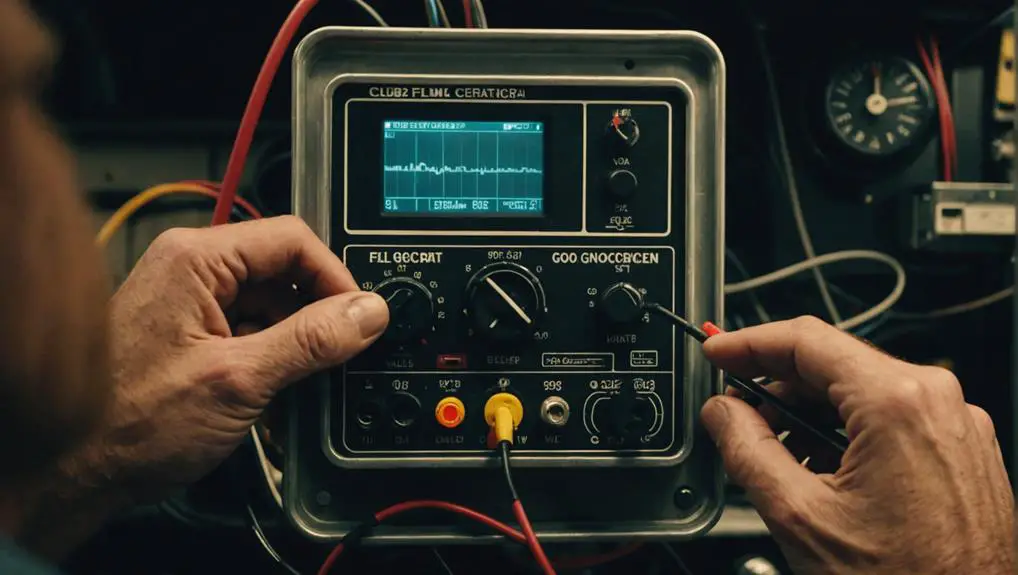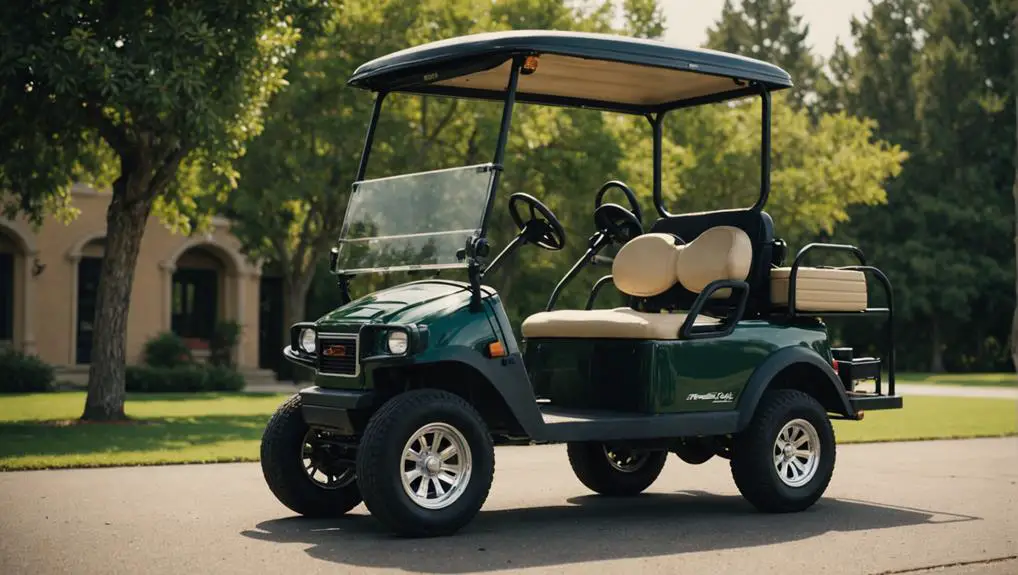Your Club Car golf cart is like a well-tuned instrument; when it's not performing, it can disrupt your game. You might face issues such as a lack of power or an unexpected stall, leaving you with questions. By systematically troubleshooting these problems, you can restore harmony to your ride. Understanding where to start and what to check can make all the difference, especially when you're unsure what's causing the trouble. So, let's explore the common issues and the steps you can take to get your cart back on track.
Key Takeaways
- Regularly check battery connections for corrosion and ensure terminals are tight to maintain power flow.
- Inspect the drive belt and rear axle for wear or damage to prevent erratic movement.
- Examine the fuel system, including fuel levels and lines, to ensure optimal engine performance.
- Monitor tire pressure and tread depth to guarantee safe and efficient driving.
- Seek professional help for persistent issues or unusual noises indicating deeper mechanical problems.
Common Golf Cart Issues
When dealing with a Club Car golf cart, you might encounter several common issues that can hinder its performance.
One frequent problem is a lack of power, which often stems from a weak battery or corroded connections. Make certain to check the battery voltage and clean the terminals to guarantee proper power flow.
Another issue is the cart's inability to move, which may be caused by a malfunctioning solenoid or worn-out controller. Inspect these components for any signs of damage or wear and replace them as necessary.
You might also notice that your golf cart runs erratically or has a rough ride. This could indicate problems with the drive belt or the rear axle.
Inspect the drive belt for fraying and ensure that the rear axle is properly lubricated.
Diagnosing Engine Problems
Power issues and movement failures often lead to questions about the engine's performance in a Club Car golf cart. To diagnose engine problems effectively, follow these essential steps:
- Check for fuel supply: Verify there's enough fuel in the tank and that the fuel lines are clear and unobstructed.
- Inspect the air filter: A clogged air filter can restrict airflow, affecting performance. Make sure it's clean and functional.
- Examine the spark plug: A worn or damaged spark plug can hinder ignition. Check for wear and replace if necessary.
Start by examining the fuel system. If you notice a lack of fuel flow, it could be due to a faulty fuel pump or filter.
Next, inspect the air intake system. A dirty air filter can greatly impact engine performance.
Electrical System Troubleshooting

When troubleshooting the electrical system of your Club Car golf cart, start by checking the battery connections for any corrosion or loose terminals.
Next, inspect the wiring for signs of wear, fraying, or disconnections that could affect performance.
Addressing these issues promptly can restore functionality and prevent further complications.
Battery Connection Issues
Although battery connection issues can seem intimidating, addressing them is crucial for keeping your Club Car golf cart running smoothly.
Poor connections can lead to insufficient power, affecting performance and longevity. Here's how to identify and resolve these issues effectively.
First, check the battery terminals. Verify they're clean and free from corrosion.
Corroded terminals can hinder the electrical flow, leading to poor performance.
Next, inspect the wiring. Look for loose, frayed, or damaged wires that could compromise the connection.
Finally, confirm the battery voltage. Use a multimeter to measure the voltage; a reading below the recommended level indicates a charging issue or a weak battery.
Here are some signs of battery connection issues you might notice:
- The golf cart struggles to start or doesn't turn over.
- You experience intermittent power loss while driving.
- There's visible corrosion or buildup around the battery terminals.
Wiring Inspection Steps
A thorough wiring inspection is essential for diagnosing electrical system issues in your Club Car golf cart. Start by disconnecting the battery to guarantee safety.
Next, visually inspect the wiring harness for any signs of wear, fraying, or corrosion. Pay special attention to connectors and terminals, as these are common failure points. Use a multimeter to check for continuity in the wires; this will help you identify any breaks in the circuit.
Once you've checked the wires, examine the fuses and relays. Replace any blown fuses and verify that relays click when activated. If you suspect a specific component, trace the wiring back to it, looking for loose connections or damage along the way.
Don't forget to inspect the ground connections, as poor grounding can lead to erratic behavior. Clean any corroded terminals with a wire brush and reconnect securely.
Battery Maintenance Tips
To keep your Club Car golf cart running efficiently, perform regular battery checks to monitor voltage and fluid levels.
Always follow proper charging practices, ensuring you charge the batteries fully without overcharging.
Regular Battery Checks
How often do you check your golf cart's batteries? Regular battery checks are essential for guaranteeing peak performance and longevity. You should inspect your batteries at least once a month, especially if you use your cart frequently. This proactive approach helps you identify potential issues before they escalate.
Here are some key aspects to focus on during your checks:
- Fluid Levels: Verify that the electrolyte levels are adequate. If they're low, add distilled water to the cells, but never overfill them.
- Corrosion: Look for signs of corrosion on the terminals. If you see any, clean them with a mixture of baking soda and water to maintain a solid connection.
- Connections: Check the battery cables for tightness and wear. Loose or frayed cables can lead to poor performance and potential failure.
Proper Charging Practices
Proper charging practices are essential for maintaining the health and efficiency of your golf cart's batteries. To start, always use the charger specifically designed for your golf cart model. This guarantees compatibility and peak charging performance.
When charging, plug in your cart as soon as you finish playing. Don't wait for the batteries to fully deplete; ideally, charge them when they reach about 50% capacity.
Make certain to keep the battery terminals clean and free from corrosion, as this can impede charging efficiency. Before connecting the charger, inspect the connections for any signs of wear or damage, and replace any defective components promptly.
During charging, monitor the temperature of the batteries. If they become excessively hot, disconnect the charger and allow them to cool before resuming.
After charging, make sure the batteries are fully topped off with distilled water if necessary, but only after the charging cycle is complete.
Tire and Suspension Checks

Inspecting the tires and suspension of your Club Car golf cart is crucial for guaranteeing a smooth and safe ride. Regular checks can help you identify potential issues before they escalate, keeping your cart in prime condition.
Start by examining each tire for signs of wear, such as uneven tread or bulges, which can indicate a need for replacement.
Next, check the tire pressure. Proper inflation is essential for performance, traction, and fuel efficiency. Use a reliable tire pressure gauge to verify each tire meets the manufacturer's recommended PSI.
Finally, assess the suspension system. Look for any signs of damage or wear on the shocks and struts. Confirm that no components are loose or leaking fluid. A well-maintained suspension improves ride quality and handling.
Here are key areas to focus on during your inspection:
- Tread Depth: Confirm there's adequate tread for grip and safety.
- Pressure Levels: Maintain the correct PSI for peak performance.
- Shock Condition: Inspect shocks for leaks or damage to guarantee proper function.
When to Seek Professional Help
When you're experiencing persistent issues with your Club Car golf cart, it's time to contemplate seeking professional help. If you've gone through basic troubleshooting—checking the battery, fuses, and connections—without success, a professional mechanic can provide the expertise you need.
Look for signs such as unusual noises, erratic behavior, or complete power loss. These could indicate deeper mechanical or electrical problems that require specialized tools and knowledge. If your golf cart's performance declines despite regular maintenance, don't hesitate to consult a technician.
Additionally, if you notice fluid leaks or significant wear on vital components like the motor or transmission, it's essential to act promptly. Ignoring these symptoms can lead to more significant damage and costly repairs.
It's also wise to seek help if you're unfamiliar with electrical systems or unable to use diagnostic tools effectively. Professionals can quickly diagnose issues and recommend appropriate repairs, saving you time and potential frustration.
Frequently Asked Questions
How Can I Improve My Club Car's Speed?
To improve your Club Car's speed, start by checking the battery's condition; weak batteries can limit performance.
Verify the tires are properly inflated and in good condition, as low pressure can slow you down.
Consider upgrading the controller or motor for enhanced power.
Regular maintenance, including cleaning the terminals and inspecting the speed sensor, also helps.
What Accessories Can I Add Without Affecting Performance?
To enhance your Club Car without compromising performance, consider adding lightweight accessories like a sun canopy or a custom steering wheel.
These modifications won't considerably alter the cart's weight or aerodynamics. You can also install LED lights for better visibility without impacting speed or efficiency.
Make sure you choose high-quality components designed for your specific model, as poor-fitting accessories can lead to performance issues or safety hazards.
Always prioritize functionality alongside aesthetics.
Are There Specific Maintenance Schedules for My Model?
Regular maintenance is essential; studies show that well-maintained golf carts can last up to 30% longer than neglected ones.
For your model, follow a maintenance schedule that includes checking the battery every month, inspecting tires and brakes quarterly, and performing a full service annually.
This routine will guarantee peak performance and longevity. Always consult your owner's manual for specific intervals tailored to your model for the best results.
Can I Use Regular Car Parts for My Golf Cart?
You can't use regular car parts for your golf cart, as they're designed for different specifications and performance requirements.
Golf carts typically have unique components tailored for their lighter weight and specific operational needs.
Using standard car parts might lead to improper fitment, reduced performance, or even damage.
Always opt for parts specifically designed for your golf cart model to guarantee safety, reliability, and peak functionality.
How Do I Winterize My Club Car Golf Cart?
Winterizing your Club Car golf cart might seem unnecessary, like putting a coat on a snowman, but it's essential.
Start by cleaning it thoroughly, then remove the battery and store it in a warm place.
Check and maintain tire pressure, and make certain your fuel system has stabilizer.
Finally, cover your cart with a breathable tarp to protect it from moisture and debris.
You'll keep it in top shape for spring, and that's the goal!
Conclusion
By following this troubleshooting guide, you can efficiently address common issues with your Club Car golf cart. Don't let a minor problem turn into a major inconvenience—imagine the frustration of being stranded on the course. Regular maintenance and timely repairs can keep your golf cart running smoothly, ensuring you enjoy every round without worries. If the problem persists, remember that seeking professional help is always a wise choice to maintain the safety and performance of your cart.